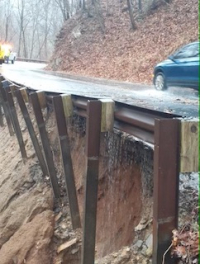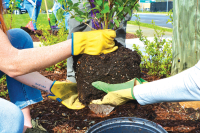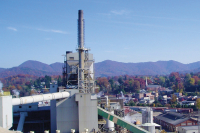Maggie may mandate mountain motif
The days of building as you like in Maggie Valley may be numbered, with design standards in the works to guide the town’s commercial district toward a mountain theme.
Maggie Valley’s planning board has released a draft version of standards that would shape the town’s look for generations to come.
If all goes according to plan, the standards will improve the community’s appearance and preserve the natural environment, all while boosting tourism and the local economy.
They would apply only to the commercial district, which includes practically every property that touches U.S. 19, the main drag through town, excluding single-family homes and duplexes.
If the standards are adopted, any new construction or major renovation to existing businesses would have to gain town approval before moving forward. Less major renovations, like a new roof or an exterior paint job, would have to comply only with the standards associated with that particular job.
As the guidelines stand, Maggie Valley would encourage steep pitched roofs, subdued, earthy colors and use of natural materials like wood and stone.
Related Items
It would also strongly discourage buildings with blank walls, stucco or vinyl siding, and visibly flat roofs. Business owners who plan on slapping Day-Glow or fluorescent-colored paint on their building exteriors would have to rethink their plans.
In addition to guiding construction, the standards would require more greenery along public streets and in parking lots to soften up the big block of U.S. 19 that cuts through much of Maggie Valley. The guidelines even go so far as to recommend using regionally grown plants.
Maggie Valley’s new seven-person appearance commission would examine each project individually to accommodate for special circumstances, rather than dictate the same exact look for every building. The town board, however, would make the final decision on every proposed project.
Not a done deal
Planning Director Nathan Clark said now is the perfect time to shake up the status quo in Maggie Valley. Because construction is pretty much at a standstill, the guidelines would not interfere as much with works in progress. Once the economy rebounds, builders would already have an established template for their new projects.
Other than that, Clark sees the need to update the town’s appearance, eventually exchanging the 1950s-style look of some businesses for something more native to the mountains.
In coming up with the design standards, the planning board looked at trends around town. The mountain theme seemed to dominate most recent projects, including at the Smoky Falls Motel, the new police department, and the new ABC store.
Clark said the new theme might bring tourists crawling back to a town that seemed to never change, while planning board member Tom Benoit said visitors driving by for the first time might recognize it as the quintessential mountain town they’d like to check out.
“You’ve seen the same old Maggie Valley for so many years,” said Clark. “Some people appreciate that, but the numbers are showing people are getting tired of that as well.”
Clark said that the standards are by no means a done deal. The planning board is still focusing on getting public feedback and trying to produce the best standards possible. Ultimately, whether or not to enact the standards will rest with the town board of aldermen.
Business owners react
Some business owners are thrilled about the standards, while others see no need to implement them.
At the latest planning board meeting, Michael Seifert, owner of the Alamo Motel in Maggie Valley, said he’s worried about placing constraints on businesspeople who’ve just come in to town.
“There needs to be more flexibility,” said Seifert.
For Allen Alsbrooks, owner of the Hearth and Home Inn, the standards were like a “slap in the face.”
“This tells me that what we have is definitely not good enough,” said Alsbrooks, adding that installing the mountain-themed look on his business would not pay for itself.
Some motel owners argued it would be unfair to impose these guidelines on a business forced to renovate due to a fire, for example.
Clark’s reply was the town could address those issues as they arise since each project would be looked at individually, adding that the town would remain realistic in its expectations.
“The town would not expect every building to have rock since it is so expensive,” said Clark.
There would also be no date by which all buildings in the commercial district had to conform to the theme, Clark said.
Most members of the Haywood County Hotel and Motel Association, representing 48 tourism-related businesses, approve of the standards, according to Executive Director Marion Hamel.
“Anything that could make us more attractive to tourists is something we really need to do because that’s our only industry,” said Hamel. “I think we’ve got an awful lot to offer. We just need to have a little more eye appeal.”
Hamel acknowledges that these are tough economic times, but she pointed out that the changes wouldn’t be occurring overnight. And business owners would have to make changes to their building exteriors sooner or later anyway, Hamel said.
“I think it would only add to their business volume, rather than just be a drain,” said Hamel.
There is one thing Hamel would like to change about the design standards though.
“I would like to see the town be a little stronger in saying any new construction needs to conform to standards,” said Hamel.









